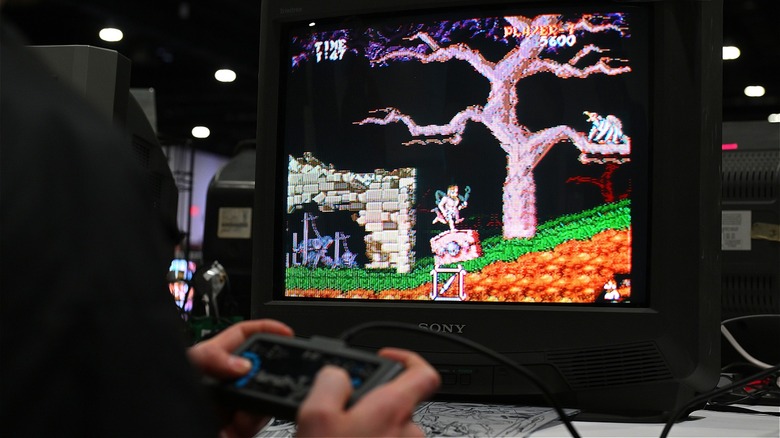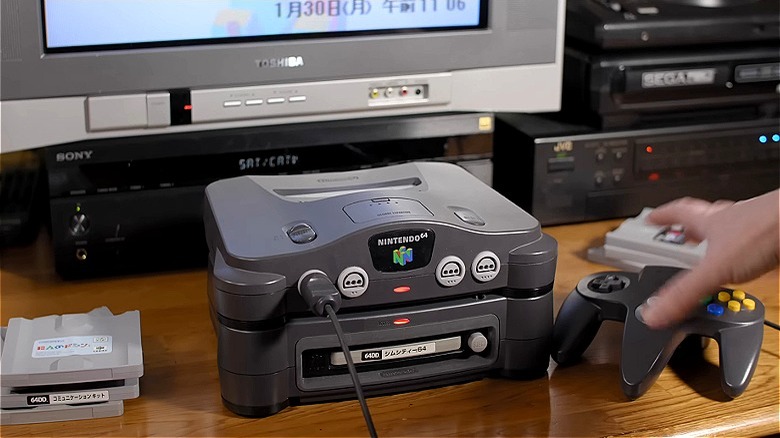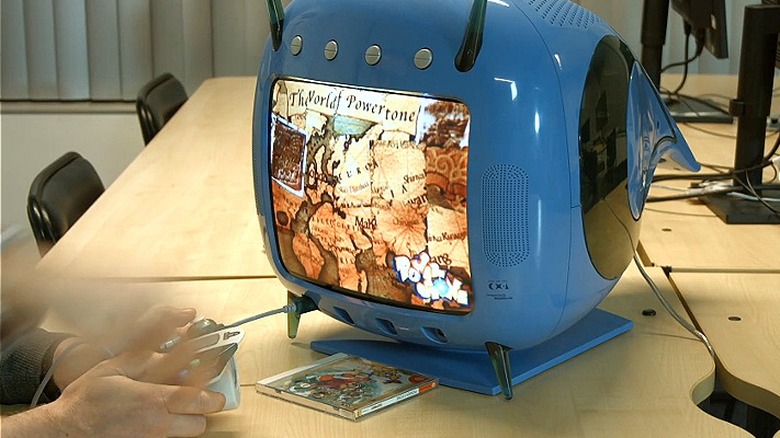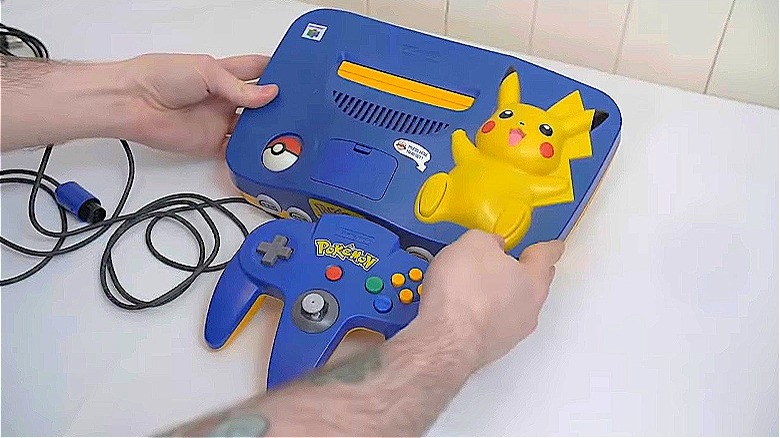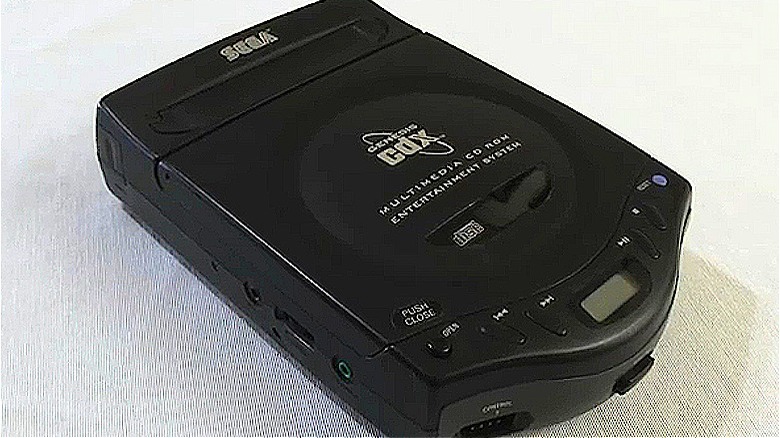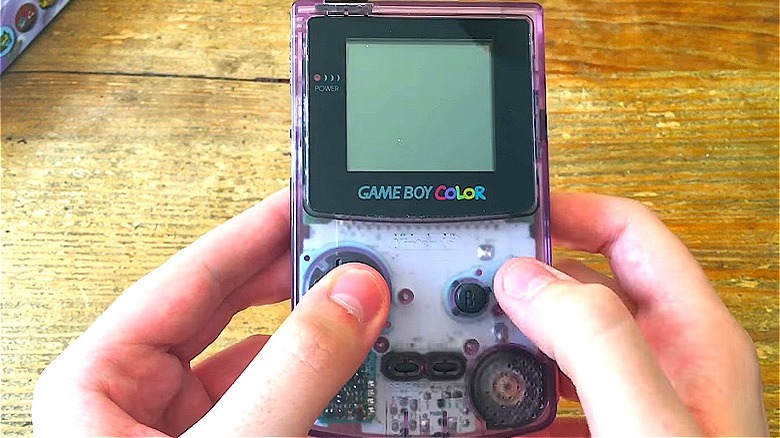The Unexpected Value Of Old Video Game Consoles Today
Gamers today have it so good. Ergonomically designed gaming chairs, luxury gaming headsets, LED-covered accessories, and seemingly inflation-proof TVs, the tools for today's avid gamers are all around us. What's more, games are available on apps, computer systems, not to mention whatever "smart" headgear is currently in development by your friendly neighborhood social media and tech overlords. But not so long ago, games were largely played on video game consoles, like the one you've long stored away.
Of course, new iterations of gaming consoles still exist today. Take the candy-colored Nintendo Switch console family, for example. But in the days when cellphones were new, gaming technology used to be mind-blowing, as you know, and mostly contained in neutral-toned plastic. Today, those humble hulks of "retro" gaming consoles might be worth a pretty penny, as evidenced from past sales. To learn the possible value of your old video game console, you don't need to enter up, up, down, down, left, right, left, right, B, A, and Start (aka the famous Konami Code) on your game controller. Just read on.
Nintendo 64DD (1996)
Some video game consoles that are rare today were also rare in their heyday. Take, for example, the Nintendo 64DD magnetic expansion system. The DD was short for "Disk Drive" in this 1996 add-on offering that was only released in Japan, though the system was intended for wider-scale release, in hopes of competing with its then-rival, the Playstation CD-ROM system. It's wild to think now, but the disks this system brought to a CD-ROM fight were of the floppy variety.
Floppy disks don't get the video game glory that they perhaps deserve, but back in 1995, they could hold up to 64MB of data. Not bad for a video game thinner than a CD and ideally less dusty than the usual video game cartridges of the day. But what the DD boasted in storage capacity at the time, it didn't in wow-factor. Nintendo scuppered a wider release, instead redeveloping DD games for N64.
While the DD didn't become the contender Nintendo wanted it to be, it has since become a relic of gaming legend. This is likely due to the expansion's strangeness and scarcity, and the item's role in the console wars between Nintendo and Sega. Today, a sealed or mint-condition 64DD runs between $1,300 and $1,500. As time goes on, the systems, of course, only become more rare. Even a 64DD manual was listed for ~$450 in 2024.
SEGA Dreamcast Divers 2000 Series CX-1 TV Limited Edition (2000)
Very few gaming consoles escaped the early aughts without at least one experiment with colorful, translucent plastic housings, and the SEGA Dreamcast Divers 2000 Series CX-1 TV Limited Edition might just be the pinnacle of such experimentation. Released in (surprise) the year 2000, this SEGA Dreamcast and TV set combo also came with a themed remote control, keyboard, camera, and game controller. If that sounds like a big deal, it was. This was a pricey item even for the time, and only released in Japan. Further, only 5,000 units were ever produced.
Such a distinction comes at a cost. In 2024, this nautical bubble of gaming technology sold for $15,000 on Retropixl, while a tested, used system is listed for as high as $26,000 on eBay. Some of the systems listed for sale even claim to be open-box, but unused, for the low starting price of $17,999.
Pikachu Nintendo 64 Set (2000)
The power of cute gaming consoles should never be underestimated, and nor should the power of Pikachu. The playful "Pokémon" video game, anime, and movie franchise star has been emblazoned on everything from pillowcases to plush toys to pasta. And the little yellow rodent of repute has been popular on merchandise practically since his video game debut in 1996. So it only makes sense that a Pikachu-themed video game console is a popular (and possibly quite valuable) collectible today. (By the way, Pikachu leads this roundup of Pokémon cards that are worth a ton of money, too.)
A Nintendo 64 console (available in either blue or orange) with a plastic-molded yellow Pikachu built into the housing was released in 2000 in Japan and the United States. The set also came with a themed controller, featuring a an on/off switch that looked like a Poké Ball and a Pikachu-foot reset button. Collectors looked for systems and replacement controllers for the system after the release, and could attain both for relatively low prices via flea markets, resale shops, and message boards as early as 2014. YouTube and social media posts have helped keep the cute and solid system's popularity alive ever since, which has helped reinvigorate the product's collectible status.
PriceCharting cites a new factory-sealed unit for just under $3,475, while a loose unit goes for ~$271. Value depends on what evolution the system is in, as one brand-new, factory-sealed Pikachu Nintendo 64 set was listed on eBay in 2024 with a buy-it-now price of $28,000.
SEGA Genesis CDX (1994)
While many gaming consoles released internationally enjoy a fairly immediate resale market fueled by domestic collectors looking for the latest tech, the SEGA CDX was rare on U.S. turf from the get-go, even though it was initially released here in 1994. The SEGA CDX is a mobile CD-based game console, which seems to answer the question of what happens when you combine a SEGA Genesis with a Discman?
The SEGA CDX could play SEGA Genesis games as well as SEGA CD games, and music CDs. One look at this deeply mid-'90s, all-black plastic piece of tech, and you can practically hear tinny techno house music playing through it. The system came out toward the end of SEGA's push to make SEGA CD happen. This wasn't exactly a successful attempt, as the SEGA CDX had an extremely high price point, especially for the time: $399.99 a unit.
The portable console was discontinued the year after its release, but a collectors' market sprung up then and now to scoop up the strange, small, sleek system. Collectors tend to share their hauls via message boards, and most posts note a genuine appreciation for the system. In 2024, PriceCharting cites loose models of the SEGA CDX are being listed for $443 or so, complete in-box listings for $1,499.99, and factory-sealed models for $3,750.
Atomic Purple Game Boy Color (1998)
Anyone who believes "cellar door" is the most beautiful phrase in the English language has yet to hear "Atomic Purple Game Boy Color." The handheld gaming console was released in 1998, as an eye-catching upgrade to the 1989 gaming console classic, the Nintendo Game Boy. The Game Boy Color would be significant if only for shifting the handheld housing out of neutral territory and into the world of color, including the aforementioned "Atomic Purple," a translucent shade of lilac that packs a powerful nostalgic punch in a small plastic package. This fan-favorite color, along with the other models in the line, offered a vast library of 8-bit games to play, and is now sought after by collectors.
Many gamers on the hunt for this particular shade of shell are chasing after childhood memories of their own long-forgotten handheld systems. Message board threads about the Atomic Purple Game Boy Color explore value and validity of purchases, as well as advice from one collector to another. In 2024, a new, factory-sealed model is listed on PriceCharting for ~$963, while the more common loose models are listed for around $67. Resale sites like eBay or Etsy also tend to have listings for used or refurbished models in the $150 to $190 range. Maybe that's enough motivation for nostalgic gamers with an Atomic Purple hotcake on their sands to look to sell, or possibly to charge the old console up for one more rousing round of "Donkey Kong Country."
